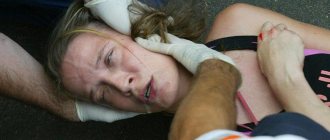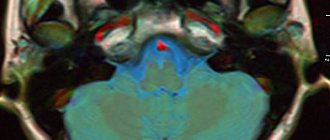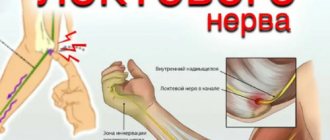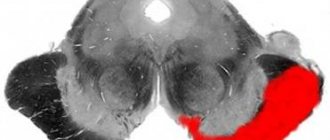All infections are dangerous to varying degrees, and even more so are neuroinfections. The most dangerous neuroinfections are those that affect the brain. There can be no “frivolous” diseases here. Every pathogen that can cross the blood-brain barrier poses a huge danger to human health and life.
Types of Brain Infections
The variety of neuroinfections affecting the brain can be divided into five groups:
- bacterial;
- parasitic;
- viral;
- prion;
- fungal.
Bacterial infections
A huge number of pathogens related to bacterial infections can affect the brain. Diseases such as meningitis, encephalitis or brain abscess may well be caused by such “ordinary” pathogens as pneumococcus, staphylococcus, and enterobacteria. But this can only happen if:
- damage to the bones of the skull, with disruption of the integrity of the membranes of the brain;
- introduction of pathogens during neurosurgical operations;
- the presence of a purulent focus in the body and weakened immunity.
However, with other pathogens the situation is different.
Meningococcal infection is a traditional neuroinfection that affects the brain. The peak incidence is observed in the autumn-winter period, when the immune system is reduced due to frequent hypothermia and lack of vitamins. If the immune system is normal, then you will limit yourself to ordinary nasopharyngitis; otherwise, the likelihood of getting meningitis or meningoencephalitis increases.
Symptoms of meningococcal infection
- fever,
- increase in body temperature to 39-40° C.
- chills,
- headache
- weakness
- neck muscle tension
- nausea,
- vomit,
specific symptoms
- A red-violet rash protruding above the surface of the skin, the elements of which resemble a star in shape
- The disease begins very acutely (often you can specify a specific time (hour) when the person fell ill)
- Treatment must begin within 24 hours while the person is conscious, otherwise he may fall into a coma.
Mycobacterium tuberculosis, among other things, can also affect the brain. Children, elderly people and people suffering from immunodeficiency are more often affected.
The symptoms of the onset of the disease are not clearly expressed, most often it is general weakness, malaise, lack of appetite, headache and irritability, body temperature is subfebrile (the temperature rises over a long period of time within 37.1 - 38°C.). Subsequently, “usual” meningeal symptoms appear.
Afterwards, neurological disorders appear - paresis and paralysis of the facial nerve, oculomotor muscles, dizziness. Mental disorders occur against the background of neurological disorders.
Neurosyphilis, now almost never occurs, but before the discovery of penicillin it formed the basis of the work of neurologists. Neurosyphilis comes in several types:
- Asymptomatic, occurs without any special symptoms, the disease can only be detected by testing.
- Meningitis - often appears during the first year of the disease, manifested by disturbances in the functioning of cranial nerves and increased intracranial pressure (ICP).
- Cerebrovascular - occurs mainly in the 2-5th year of the disease and can lead to a stroke or transform into tabes dorsalis or progressive paralysis.
- Progressive paralysis is a disease that was also called “crazy paralysis.” Occurs 15-20 years after infection and first manifests itself with mental symptoms, then muscle paralysis occurs and progresses, which ultimately leads to death.
- Congenital, which, strictly speaking, affects the entire body and is characterized by multiple defects in the development of the child.
- Gumma of the brain - manifests itself as a space-occupying formation. Symptoms include increased ICP and focal symptoms, depending on the location of the gumma.
An unpleasant feature of the disease is its difficult diagnosis.
Among organic brain lesions, cases with impaired sensory synthesis, anosognosia and mental alienation syndrome were observed with severe epidemic encephalitis, trauma, brain tumors, subdural hemorrhage, etc. A total of 16 clinical observations.
12. Patient B., 29 years old, disabled. He was observed in the clinic for 3 years.
History: no pathology in the family, grew and developed normally, was lively, calm, balanced, active, progressed well and quickly in his career. He suffered from measles in childhood, from typhoid fever at the age of 20, and from gonorrhea at the age of 22 and 26. Once he was poisoned by fish, there was vomiting, high fever, severe dyspeptic disorders, he did not sleep for about four days, he had dizziness, when he tried to get up and stand up, “it hit me like a butt on the head,” causing the patient to fall. I was ill for 8 days and became very weak. A month after the poisoning, those around him began to notice a change in his character: he became irritable, restless, and impatient. Periodically, for several hours, mood disorders and states of some kind of “intoxication” set in; thoughts flowed slowly, the patient became clumsy and sluggish. Work became more and more difficult, and later the patient could no longer cope with work. A year later he went to the doctors, who diagnosed him with encephalitis and transferred him to disability status. Periodically, peculiar “attacks” began to be observed, which lasted for several hours. During an attack, the patient becomes sad, anxious, feels a rush of blood to the head, the environment and people fluctuate like shadows, it seems not real, not the same as in normal times. The patient himself also seems to himself to be special, extraordinary, a “person of world significance”, on whose life and actions many natural phenomena and political events depend. Two years later, new “attacks” appeared; the patient feels his body, feels pain, but it seems to him as if the body is not his, as if the “soul” leaves the body and controls it from the outside. These attacks alternate with each other. Over the last 2-3 years, thoughts about the extraordinary nature of one’s personality have become constant and are not corrected by any arguments, stiffness and hypochondriacal statements are increasing.
Objectively: from the neurological status - severe parkinsonism, stiffness, mask-like face, left-sided spastic hemiparesis, anisocoria, facial asymmetry with drooping of the right nasolabial fold, tear cogwheel symptom, increased salivation, poorly modulated speech.
In the clinic: the patient is intrusive, annoying, expresses delusional ideas of greatness, significance and interpretation associated with the characteristics of his personality, he is a special, wonderful person, the life of all humanity is connected with his life. If a sick person dies, the whole world, all of humanity, will die. Every word spoken by the sick increases the population. Money that has been in the hands of the patient becomes irredeemable. The war in Korea, etc., depends on the patient’s condition. The patient’s organs are extraordinary, special; after opening the body, scientists will make a discovery of world significance; the patient’s blood has special healing properties, especially during attacks, etc. Paroxysmally, the patient experiences attacks of two kinds, lasting several hours. “Attacks” are accompanied by a vegetative reaction: redness of the face, increased salivation and increased stiffness, a sad, irritable mood. “Attacks” of the first nature consist in changing the reality of the environment: people and the situation change, they seem unreal, strange. The patient’s body seems to be filled from the inside, something is humming, like a motor. Thoughts flow quickly, in a string. Delusional ideas of greatness and significance become more acute. During the second attack, the phenomena of depersonalization predominate: the patient ceases to feel his body—“my hand and not mine.” It seems that the soul leaves the body and controls it from the outside. The phenomena of unreality, depersonalization and hypochondria are increasing.
This case is quite demonstrative of the presence of periodically paroxysmal psychosensory disorders and experiences of split personality. These conditions occur against the background of exacerbation of neurological and autonomic symptoms characteristic of epidemic encephalitis. These attacks are stopped by sleep, similar to the relief of paroxysmal tonic convulsions of the eye muscles in epidemic encephalitis; the phenomena of alienation and split personality in this case served as material for delusional interpretations, which later turned into delusional ideas of meaning and greatness. The patient's personality outside of attacks is relatively preserved, especially in the light intervals between paroxysmal psychosensory disturbances. During the periods of these short-term attacks with alienation, changes in the clarity of consciousness were observed in the form of a dream-like stupor. These states, as a rule, ended in deep sleep.
Let us present a clinical observation of a patient with pathological personality development, with a syndrome of duality and depersonalization after subdural hemorrhage.
13 Patient M, 37 years old, housewife, was transferred to the clinic from the hospital with complaints of headaches; a feeling of swaying when walking and in bed, a feeling of emptiness and dullness in the head, a short-term experience of separation of one’s “I” from the body with a feeling of bliss.
The patient has a respiratory build with dysplastic features, is somewhat emaciated, and anemic. Neurologically, tremor of the fingers, slight asymmetry of the face. exophthalmos, high tendon reflexes, with General irradiation, with clonus-like twitching; red, merging, persistent dermographism; slight enlargement of the thyroid gland.
The patient developed an impressionable, capricious and whiny character in childhood. At the age of 10, she was repeatedly subjected to attempts by her uncle to have sexual intercourse. After she understood the meaning of these sexual perversions, she fell into depression and suffered for a long time; it seemed to her that she was unclean, depraved and could not communicate with other girls. She began to avoid people, became withdrawn, shy, and sought loneliness. After graduating from school, she studied in Moscow, at the Higher School, then a year later she moved to Rostov, where she entered the Faculty of Physics and Mathematics. She was interested in theosophical and occult literature. Sometimes she participated in spiritualistic seances. Gradually, a certain worldview took shape: she imagined that in nature there is a certain omnipotent mind that controls the universe. She often indulged in deep introspection: “It seemed to me that besides my body there was something else, well, let’s say, a soul. If my body was dirty, my soul was something independent, clean. Nothing can pollute the soul.” Gradually she overcame the psychological trauma of childhood and even began to forget it. After typhus, the patient dropped out of school and went home to the village. Got married. At first, my husband and I lived well. However, after 6 months they separated due to the fact that the husband did not want to have children. One day, while working in the field in extreme heat, as a result of insolation, she suddenly fell into a deep faint, which lasted about 2 hours. They brought him to Rostov and placed him in the nervous department of the hospital. After fainting, left-sided hemiparesis was discovered. After spinal punctures it became better; She was discharged from the hospital with a diagnosis of subdural hemorrhage. A year later, the patient was admitted to a psychiatric clinic. She complained about the feeling of a split personality: “It seemed that something foreign, alien was approaching me, taking possession of me - something evil, not characteristic of my nature.” The outside world seemed hazy, not real, but her inner experiences were vivid: “My personality is split, my “I” seems completely separate from the body, anger and emotions emanate from the body.” Complaints of headaches, burning hands and feet, nausea, excessive salivation. She was discharged from the clinic without improvement. At home she felt a general weakness, obsessive thoughts about the murder of her father, whom she adored. She experienced paroxysmal feelings of separation of her “I” from a body that seemed alien to her. These states were accompanied by a feeling of bliss. She experienced lightness and clarity of thought and a wonderful mood. These conditions occurred infrequently. After a few months, there appeared sensations of swaying when walking and in bed, a feeling of emptiness and dullness in the head, a slowdown in associative activity and speech, and a feeling of freezing of the hands and feet. After 6 months, she was admitted to the clinic again.
In the clinic: the patient has a clear consciousness and correct behavior. Emotionally unstable, somewhat lethargic, inhibited. There is frequent laughter. He says that laughter occurs involuntarily; sensations of enlargement and reduction of the head, swaying of the body in bed; the ceiling of the Bremens seems to be approaching and then receding. Sometimes an inexplicable feeling of frustration and anger. The experience of the unreality of the environment, splitting and separation of one’s “I” from the body, occurring suddenly. She often says that her emotions have faded, “the feeling of sympathy and love for others is fading away.” However, objectively the patient is alive; expressive facial expressions. At times, the patient suddenly experiences paroxysmal clonus-like twitching of the limbs, lasting several minutes in the presence of complete clear consciousness, occurring without previous emotional experiences. She was discharged after a few months with significant improvement. Over the next 5–0 hours, the patient was periodically treated with outpatient hypnosis in the clinic. Easily enters a hypnotic state. Several times, for the purpose of experiment, the patient was inspired to completely separate her “I” from her body. Moreover, the patient describes her condition as follows: “I could not move my arm or leg, my body was numb. Suddenly it seemed to me that I became light, weightless, I didn’t feel my warmth at all. It seemed that I had left my body, the connection between me and the body was broken. There was a pleasant feeling of absolute peace, an almost blissful state.” The patient is able to work, works and at the same time studies in nursing courses. He studies well. Intelligence is good. Somatically he feels satisfactory. Periodically, states of alienation of one’s body and the surrounding environment appear.
The peculiarity of this case is that the phenomena of alienation and feelings of dual personality appeared in the patient a year after the subdural hemorrhage with left-sided hemiparesis. I experienced a feeling of separation of my “I” from my body, and that’s interesting. that at that time she had clarity of thought and a wonderful mood. She considered sudden, unaccountable and inexplicable attacks of anger and cruelty to come not from her “I”, but from her body, and therefore they seemed alien and unusual for her personality. These conditions occurred in attacks. The patient loses feelings of sympathy and closeness to people and becomes even more withdrawn from the environment. Subsequently, on a somatogenously arising pathological basis, the patient’s personality undergoes a peculiar development with paranoid components.
Over the next 5-6 years, the patient periodically and briefly, in a less intense form, experienced similar states of personal alienation. The patient is easily susceptible to hypnotic suggestion. During a hypnotic experiment, when she was encouraged to separate the self from the body, she again experienced a blissful state. It is possible that this pleasant experience in a state of alienation of one’s “I”, in addition to biological reasons, is also explained by a mystical mood, the patient’s conviction in the independent existence of the “substance “I”.
In case of brain injuries, cases with the phenomena of disintegration of sensory synthesis and mental alienation are quite rare. Below are these observations.
14. Patient T., 36 years old, chairman of the village council, was admitted to the clinic with complaints of strange sensations: as if teeth, lips, and tongue were flying out; the head seems to be growing. Doesn't feel body weight. When looking at objects, it seems that some kind of shadow sits on them. Requests surgical assistance.
The body type is closer to athletic. From the somatic side: heart sounds are muffled, pulse is 100 per minute. The skin is pale, with areas of pigmentation on the skin of the face and neck. Neurologically: mechanical excitability of muscles, tremor of facial muscles of the fingers, eyelids and tongue; tendon reflexes from the upper and lower extremities are alive. Anisocoria. Facial asymmetry. The tongue deviates to the left. Dermographism is red and persistent. There is no pathology noted in the family. He developed normally in childhood, was a healthy, calm and obedient child. He started working at the age of 16 in a mine, tried all professions, from groom to driver. A few years later he was sent to study at a Soviet party school. After graduation, he worked as a party organizer in a mine, then was nominated as chairman of the village council. Married, has one child. By nature he is soft, sociable, responsive, and is considered a good worker. In the fall, during a trip to the city in a fast-moving truck, he was thrown from the vehicle. He hit the parietal part of his head on a stone and fell into an unconscious state. He was in a semi-conscious state in the hospital for three months. Then, for several months, there was complete amnesia of the previous events. In April it got better, I was discharged from the hospital and went home and worked in the garden. In August I felt unwell. It seemed that individual parts of the body: teeth, tongue, lips, arms, legs were flying out, being pushed out; the head grows; a shadow falls on people and things.
In the clinic: the patient is calm, his behavior is correct, he constantly walks along the corridor and supports the left half of his jaw with his hand. The patient's statements are extremely stereotypical. Monotonously, without any modulation, he repeats, “that the teeth fly out, the pain hits the root of the tongue, the heart also flies out of the chest.” When looking at people and objects, he sees how “a shadow sits from above.” The shape and size of the bodies of the people around him change in his eyes: he sees how their heads lengthen, decrease, and take on “fairytale sizes.” He cannot read because “the letters fly apart.” Harsh light is annoying; the patient walks, usually protecting himself from the light with one hand, and kneading the skin of his cheek with the other. He claims that he does not feel the weight of his body - “as if I were floating on air.” The patient's speech and facial expressions are poorly modulated, his voice is monotonous, at times smiling stereotypically, and speaks of his painful suffering. Completely indifferent to surrounding events. In a conversation with him, one could hear the same type of phrases, the same words characterizing his condition. He insists that he have an operation on his cheek: “Please do the operation, it’s only 3 kopecks, if only I had a knife, I’d do it myself.” Once he stole a knife from the dining room and hid it, tying it to his penis with twine.
The patient was discharged without any improvement.
This case arose due to traumatic brain injury after a fall. The patient says that he hit the parietal part of his head on a stone and subsequently complained of pain in this area. After a long period of unconsciousness and subsequent complete amnesia, the patient gradually recovers past events in memory. Ten months after the fall, he felt a number of psychosensory disorders: experiences of pushing out and separation of individual parts of the body from his own body: teeth, tongue, arms and legs, changes in sensations of shapes, sizes of the head and limbs, experiences of lightness, lack of weight of his body. Perceptions of the shape and size of surrounding objects and people are also distorted. The extreme stereotypical behavior and weak modulation of speech are striking. The patient is constantly chained to his experiences. Emotionally lethargic, monotonous and indifferent to his surroundings. The persistence and continuity of these states is noted. Diagnosis, post-traumatic encephalopathy with damage to the senses? weed synthesis and decrease in personality.
15. Patient A., 34 years old, a driver by profession, was admitted to the clinic with complaints of stupefaction and a change in his personality. Anamnestic information: he developed correctly in childhood. After finishing the seven-year school and the secondary school, he voluntarily joined the army, where he served for three years. In 1948, during maneuvers, he received a severe concussion during a shell explosion. He was unconscious in the hospital for about 20 days. Then he was transferred to the Lvov psychiatric hospital. Consciousness was impaired, disoriented in his surroundings, he could not give his first and last names, he said that his head, heart and limbs had been replaced. He was emotionally excitable, quickly became exhausted, and had thoughts of suicide. Subsequently, the condition improved, and symptoms of derealization and depersonalization arose. A month later he came out of this state and was demobilized from the army. For 12 years he was healthy, worked as a driver, and drank large quantities of alcoholic beverages. In the past, he was bitten by a snake, was injected with serum, after which he developed serum sickness and lay ill for 10 days. In February of the following year I fell ill with the flu. He began to complain of a feeling of depression in the heart area, shortness of breath, attacks of fear, and the alienness of his body and voice.
In the clinic: objectively, the patient’s nervous system revealed smoothness of the left nasolabial fold, the tongue was slightly deviated to the left, tendon reflexes, tremor of the tongue and fingers. The patient’s personality is preserved and willingly comes into contact with others. He complains of some kind of stunned state and perceives the outside world as if in a dream. His body seems so alien that “at times I doubt whether I am Sergei or some kind of animal, and whether I even exist in the world. I speak and I don’t know if the voice is mine - it’s somehow foreign, lifeless. At times it seems that I disappear completely, only my eyes remain; I see everything, I don’t lose consciousness, but it’s as if I’m not there.” The patient does not feel well the act of eating, does not know whether he is full or not. “Until I tense up and am sure that it is me, Sergei, who is eating, I cannot start eating.” In sleep, in dreams, he feels his former self. He walks as if on cotton wool, doesn’t feel the weight of his body, “I want to step harder on the ground...” He is very worried about the loss of feelings for his family, for his children: “I love them with my mind, out of duty as a father, husband, but I miss my Soul, my heart.” It doesn’t hurt like before.” After an internal infusion of sodium amytal, the patient’s condition temporarily, for several hours, improves—“I become the old Sergei again, reality and feelings return, but, alas, for a short time, and I am again shrouded in fog.” The patient was treated with small doses of insulin in combination with aminazine, and also received a course of sodium amytal infusions. The patient's condition improved significantly and he was discharged.
This case of depersonalization syndrome to a pronounced degree is very demonstrative. 12 years after a severe concussion, in a patient with residual symptoms of post-traumatic encephalopathy after prolonged use of alcoholic beverages, a snake bite, serum sickness and influenza, the phenomena of depersonalization and sensopathy resumed.
16. Patient N., 31 years old, foreman. In March 1937, the patient began to occasionally complain of headaches. A month later, suddenly sharp headaches appeared at night, he began to scream, and vomiting appeared. Was unconscious for 30 minutes. Drowsiness appeared. Tearful, afraid of death. Disoriented at times. Transferred to a nervous clinic on May 17, 1937. According to his mother, when he was transported to the clinic, the patient asked that “they take him all, completely, so that they take his arms, legs, head, so that nothing is forgotten.”
In the clinic: neurologically - mild ataxia on the right. When standing, the bowl falls to the right. Knee reflexes D are higher than S, the rest are uniform. Superficial and deep sensitivity are normal, stereognosis is normal. Loss of the right quadrants of the visual fields. Visual acuity 0.6 bilaterally. Congestive nipples on both sides. Pupils - reaction to light and accommodation are satisfactory, napes of the right facial nerve (center). Small nystagmus to the right. Psyche: during his stay in the clinic, the patient was suddenly stunned and drowsy. After the ventricular puncture, consciousness became clearer, and it became possible to come into contact with him. Constantly lies in bed with the head in a forced position. There is an expression of confusion and concern on the face. He speaks in a whiny, plaintive voice. The state of clarity of consciousness changes in waves. He perceives surrounding objects in a distorted form: walls, beds, cups, tables and chairs are distorted, seem broken, crooked. The faces of the people around him seem disfigured to the patient; all faces, especially the lower part, are slanted to the right. At times objects move away and then come closer. He often says that he has lost his stomach, that He has two heads, and one lies side by side on the bed. loses legs: “I don’t know whether I have a leg or not.” During the period of clarity of consciousness, the patient is critical of his experiences, says that everything “seems” to him. This was especially demonstrative after ventriculopuncture. Emotionally unstable, weak-hearted, whiny. Korsakoff-like memory disorder is noted. Sometimes there is a significant decrease and difficulty in judgment and intelligence, apparently due to impaired clarity of consciousness. At autopsy, a tumor of the temporal lobe on the right with softening of the occipital-parietal region.
A patient with a tumor of the right temporal lobe develops a picture of pronounced psychosensory and gnostic disorders: a feeling of separation of the limbs and head from the body, the disappearance of these parts of the body, a feeling of two heads, distortion of the shape, size of external objects and people with a change in their spatial position and distance from the patient. The patient is in a state of severe stunned consciousness and drowsiness. It should be noted that after the ventriculopuncture, when the patient’s consciousness cleared, he was critical of his own people. psychosensory experiences.
In the literature there are many observations of states of alienation, psychosensory disorders and anosognosia in organic brain diseases. A number of authors: Petzl, Goff, Ehrenwald, Gurevich, Shmaryan and others described similar conditions with brain tumors, injuries and hemorrhages. Ehrenwald, Petzl and other authors bring these phenomena, including anosognosia, closer together and even identify them with depersonalization. Frank described three interesting clinical cases with alienation syndrome after cerebral hemorrhage and one after traumatic injury to the frontal region of the brain. In all three cases, changes in clarity of consciousness were noted. The phenomena of alienation and mental automatism came to the fore as soon as consciousness became clearer. The patients described their condition in detail and were critical of them. Elements of these symptoms persisted and persisted for a long time after the disease. Similar conditions were described in case of brain injuries by Kleist and Iserlin.
Goff and Petzl point out that with anosognosia, the uncritical projection of one’s limbs into the outside world, turning them into various objects, occurs in the presence of delinquent states of consciousness. In their opinion, there is a certain kinship here with the peculiar processing of body images in a dream, in which often some impulse to move one limb means a massive movement of the whole body in a dream.
Meyer-Gross and Steiner described one student with striopallidal syndrome as a result of an acute illness; The patient experienced numerous alienation phenomena.
Among Kleist's clinical observations with postencephalitic conditions, pronounced phenomena of various forms of alienation were noted. Geyer and Dublino described one encephalitic patient with characteristic neurological disorders who had mental disturbances in the form of bodily transformation, personality changes and changes in environmental perceptions. Their states of obsession and alienation were accompanied by excruciating fear. A number of authors (Gurevich, Mekel and Fünfgeld, etc.) also described clinical cases of encephalitis with depersonalization syndrome.
Analyzing our clinical cases, it must be said that in most of them states of blackout of consciousness of various shades were noted. The nature of the phenomena of psychosensory disorders is usually elementary, in the form of distortion of the perceptions of individual parts of the body and surrounding objects. They occur more often in a paroxysmal form. Thus, one patient with a tumor of the corpus callosum periodically suddenly felt her own nose greatly increasing in length and thickness. Another patient, also with a tumor of the corpus callosum, felt that he had two heads and four arms.
In those cases where patients have an uncritical attitude towards their states of alienation and other psychosensory disorders, it is almost always possible to ascertain the phenomena of impaired clarity of consciousness or pathological drowsiness. This is confirmed in our cases when patients, after clearing their consciousness, say that “it seems to them.”
Viral and prion infections
There are a huge variety of viruses that cause acute encephalitis (mosquito, tick-borne, epidemic), in general they differ in vectors and geography of distribution.
Focal symptoms occur against the background of “general infectious manifestations”, these are:
- paresis
- respiratory muscle paralysis
- paralysis of limbs,
- paralysis of facial muscles, etc.
Rabies and slow infections can pose a huge danger, and therefore special attention is paid to them.
Rabies. Almost all mammals can suffer from rabies. The source of infection is usually dogs, wolves, foxes, and it is through the bite of infected animals that this dangerous infection is transmitted to humans. Symptoms:
- hydro and aerophobia
- convulsions
- attacks of aggressive behavior.
Emergency vaccination after a bite is the only way to recover, so waiting for the first symptoms of the disease to develop is prohibited, since this can only indicate that the person can no longer be saved.
Slow infections are viral neuroinfections that have the ability to remain asymptomatically in the human nervous tissue for a long time, with the subsequent development of the disease.
Scientists have identified four main characteristics that distinguish slow infections:
- unusually long (months or years) incubation period;
- slowly progressive nature of the course;
- unusualness of damage to organs and tissues;
- the inevitability of death.
The causative agents of the virus are rubella and measles. For reasons that are not entirely clear, these viruses can remain in brain cells after an illness and cause disease after 4 or more years. Both viruses cause panencephalitis with similar symptoms:
Personality changes with the development of dementia
Gradual paralysis of all striated muscles.
Unfortunately, even with treatment, the consequences of these neuroinfections are always the same - death.
Prions Prions are “proteinaceous infectious (particles).” Prions are defined as “a small proteinaceous infectious particle that is resistant to inactivating influences that modify nucleic acids.” In other words, prions are ordinary proteins of the body that for some reason (which is still unknown) they begin to behave “wrongly”.
There are four types of prion neuroinfections, and only one of them has a clear transmission mechanism. In some tribes of Papua New Guinea, cases of kuru-kuru were often reported due to the previously widespread ritual cannibalism of eating the brains of relatives. Prions cause spongiform encephalopathy, which means the brain turns into a sponge.
Pathology of childbirth and the postpartum period
Fetal hypoxia and difficult childbirth with symptoms of preeclampsia increase the risk of schizophrenia, according to some data, by almost 9 times. Some authors believe that a small fetal head circumference is also an indicator of an increased risk of schizophrenia. There is doubtful evidence regarding the effect of too short a period of breastfeeding on susceptibility to schizophrenia.
An analysis of the literature devoted to the influence of pathology of the birth and postpartum period on the risk of schizophrenia shows that here, as a rule, there is a combination of a number of unfavorable factors that can negatively affect the child’s brain.
Fetal hypoxia, according to a number of researchers, is an important factor predisposing to the development of schizophrenia (almost 4 times the risk) (Zornberg G. et al., 2000). This fact was also noted by T. Cannon et al. (2002), who analyzed the anamnesis of patients with schizophrenia and schizoaffective disorders born in 1955. Neuroimaging results showed that a history of indications of fetal hypoxia correlates with the weight of the gray matter of the brain and an increase in the volume of cerebrospinal fluid. Moreover, the reduction of gray matter was most clearly noticeable in the temporal lobe. In addition, it turned out that the consequences of hypoxia depend on its duration. T. Cannon et al. (2000) noted that fetal hypoxia has a greater effect on the early, but not late, manifestation of schizophrenia. The possibility of developing hypoxia in the fetus may be indicated by a pregnant woman's tendency to hypertension (preeclampsia), which, in turn, can negatively affect the development of the fetus.
Note that in one of the studies by T. Cannon et al. (2002) found a relationship between the registration of diabetes mellitus during a woman’s pregnancy and more frequent cases of schizophrenia in her children later in life. Some authors have noted that the Rh factor (Rh) may also play a role in susceptibility to schizophrenia (Hollister J. et al., 1996). Somewhat earlier, in the works of R. Davenport (1994), it was hypothesized that deviation of the Rh system affects the role of anti-inflammatory cytokines and their effect on the development of the fetal brain.
Effects of hypoxia (ischemia) on the fetal brain
- Increased cerebrospinal fluid volume
- Decreased volume of gray matter mass in the brain (temporal lobe)
- Consequences of the influence of secondary placental insufficiency on the fetal brain (hippocampus, cerebellum, occipital lobe)
Animal studies have shown that early fetal hypoxia contributes to impaired development of the central nervous system and to some extent predisposes to the appearance of some symptoms of schizophrenia.
Studies by Rees et al. (1998) showed that hypoxia leads to the development of secondary placental insufficiency, which ultimately contributes to fetal brain damage. Particularly affected by hypoxia are areas of the brain such as the hippocampus, cerebellum and visual cortex.
Premature birth, according to some authors, is recorded in 11% of women in the general population. In some cases, they create vulnerability of the newborn's brain to infectious diseases and, in this regard, can also be considered among the factors potentially predisposing to the occurrence of mental disorders. Intrauterine infections of viral etiology, such as the herpes simplex virus, become particularly dangerous in this regard. In addition, there are works in the literature according to which premature birth weakens the body’s immune system, predisposing to the appearance of autoimmune diseases. Causes of premature birth usually include: cervical insufficiency, pathology of the shape of the uterus, preeclampsia, exposure to medications, poor nutrition and smoking. Premature birth is often combined with hypoxia, intraventricular hemorrhage and periventricular leukomalacia. Premature birth, as a rule, leads to insufficient weight of the newborn and can contribute to the pathology of the child’s development: delayed mental development, learning difficulties, and deviant behavior. The results of many studies indicate that children born prematurely are prone to substance use and criminal behavior. In some cases, during premature birth, abnormalities are found in the newborn’s brain that are typical for adolescents predisposed to schizophrenia: a decrease in the volume of gray matter in the brain, a decrease in the size of the hippocampus, and an expansion of the volume of the lateral ventricles of the brain (Peterson B. et al., 2000).
A relatively complete review of works devoted to modeling early brain damage in animals and the development of symptoms of schizophrenia is presented in the work of S. Nayakas et al. (1996).
Some researchers have proposed considering low birth weight as an indicator of susceptibility to developing schizophrenia.
Numerous studies have confirmed that children who had complications at birth are twice as likely to develop schizophrenia as those who did not have birth injuries. However, later most of the results of such studies were refuted.
Meningitis suffered at an early age, from the point of view of Brazilian scientists, increases the risk of developing schizophrenia by almost 5 times.
The hypothesis of the origin of schizophrenia due to impaired brain development in the early stages of ontogenesis (“neurodevelopmental theory”) again became popular in the 80s of the twentieth century (Murray R., Lewis S., 1987).
In a number of works, schizophrenia began to be considered as “static encephalopathy”, formed as a result of disruption of brain development processes in the prenatal period.
Probably, the weakness of the nervous system manifests itself during the hormonal changes of puberty, when the weakened structures of the brain are subject to additional stress, which ultimately leads to a failure of its functional activity and a noticeable manifestation of those symptoms that were previously mild.
Any changes in the nervous system during the initial period of life are quite difficult to reverse. This circumstance may explain the relatively unfavorable outcome of schizophrenia.
It is currently assumed that in the development of schizophrenia, a special role is played not by any damage to brain structures, but by disruption of the development of some of them, for example, the hippocampus with changes in the functional capabilities of the brain in the initial period of life.
M. Isohauni (2002), after analyzing the northern part of Finland, came to the conclusion that prenatal brain damage in most cases leads to delayed psychomotor development, but are, as a rule, just phenotypic markers of the pathological process in schizophrenia.
For schizophrenia to occur, damage to certain brain structures alone is not enough. The biological factor can be significantly enhanced by a known hereditary predisposition to this mental disorder, which outwardly manifests itself as a kind of slowness of the child’s neuromotor and cognitive development, favoring the development of some symptoms of schizophrenia, for example, autism.
It is interesting to note that minimal disturbances in the neuromotor and cognitive development of children (“minimal brain dysfunction”, “mild symptoms”), such as speech delays and dyslexia, are more often observed in boys, and as is known, in men schizophrenia begins earlier and is more malignant than women.
Recent studies on the development of the nervous system of the mature brain have shown the fallacy of statements that in adulthood a person does not form new neurons in his nervous tissue. It has become known that there are progenitor cells in the central nervous system, which are mainly localized in the hippocampus and subventricular zone near the lateral ventricles of the brain. These cells respond to a range of stimuli and give rise to new neurons in the hippocampus and olfactory bulb, the latter migrating into the olfactory bulb from the subventricular zone along the rostral migration pathway. Considering the frequent detection of structural and functional changes in these areas of the brain in schizophrenia, it can be assumed that in this mental disorder the process of neuronal maturation is disrupted not only at the early stage of ontogenesis, but also at a later age. Otherwise, it will be difficult for us to explain the presence of a long latent period between embryonic damage to the nervous system and the relatively late manifestation of schizophrenia.
In conclusion, we note that prenatal and postnatal complications, manifested in structural abnormalities of the brain, may be an additional, but still nonspecific risk factor for the occurrence of schizophrenia.
Care, recovery, rehabilitation, elderly people with dementia
Our boarding house staff have the necessary skills and experience working with patients suffering from various cognitive impairments. Our nurses and carers know how to care for older people with memory loss and ensure their safety. We provide:
- adapted, safe premises for people with brain disorders;
- constant supervision by trained staff of the boarding house;
- balanced dietary nutrition, taking into account age needs and medical recommendations;
- assistance to residents of the boarding house in eating, hygiene procedures, careful care for bedridden patients;
- necessary medical procedures, exercises to support cognitive skills, motor skills;
- psychological assistance during rehabilitation.
Signs of dementia
The aging process is always accompanied by various changes in human behavior, but changes are different from changes. Indirect signs of senile dementia in a person may include the following behavioral deviations:
- Experiences temporary memory lapses;
- Forgets the location of ordinary things in the house, while accusing loved ones of theft;
- Experiences frequent sudden changes in mood;
- Often becomes depressed and loses interest in life;
- Loses simple household skills (tying shoelaces, boiling a kettle, turning on the TV...);
- Experiences problems with speech (slowness, distortion of speech);
- Ceases to understand interlocutors, repeatedly asks to repeat what was said;
- Loses orientation in time and space;
If you notice such symptoms in a loved one, you should contact specialized institutions. According to doctors, the progression of the disease can be slowed down with proper medical care.
Dementia - senile dementia
Age-related disorders of brain activity, called dementia - acquired (or senile) dementia, are caused by the death of nerve cells in the brain and manifest themselves in a decrease in mental activity, impaired memory, speech, consciousness and behavior of the sick person.
The problem is based on degenerative changes (atrophy) of brain cells and vascular disorders, leading to a lack of blood circulation and oxygen supply to the brain tissue.
According to statistics, the first, subtle symptoms in the form of partial, temporary loss of memory, time orientation and loss of some habitual skills can appear after 50 years. By the age of 60, about 3% of older people have been diagnosed with dementia. By the age of 80, 25% of the inhabitants of our planet suffer from various types of dementia.
Dementia treatment
When dementia is diagnosed at an early stage, medication to support brain activity and exercises to train and restore cognitive function can be done at home. In any case, it is necessary to eliminate from the patient’s life the factors that influenced the development of the disease.
If you do not have enough time or a loved one’s illness has reached a more severe stage, you should think about choosing a nurse with a medical education or a specialized boarding house.
Professional care and services for an elderly person suffering from dementia is difficult to organize at home if relatives are constantly at work.
A specialized boarding house for people with dementia and other cognitive disorders, providing qualified care, treatment under the supervision of competent doctors and psychological support for the elderly.











